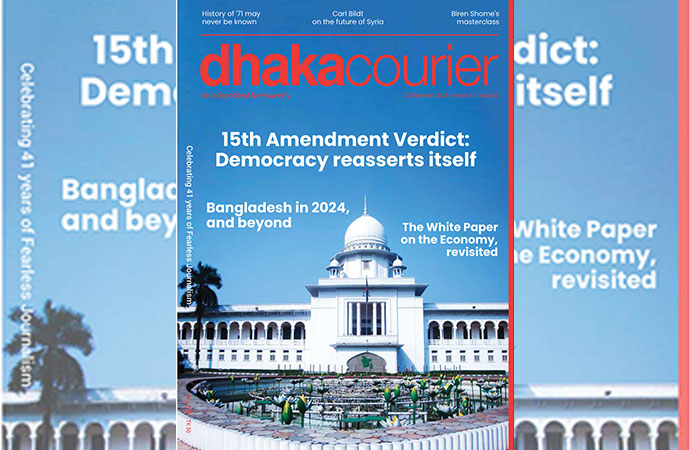Reportage

Figure 29 Service group specialization of IT and ITES firms
US keen to help Bangladesh diversify its economy beyond RMG
The Information and Communications Technology (ICT) and IT-enabled services in Bangladesh have been maintaining a double-digit Compound Annual Growth Rate (CAGR) over the last ten years. Also, the domestic market share of local IT/ITES (Information Technology Enabled Service) firms is growing rapidly, which is reducing the country's import dependency.
Despite being much smaller than global offshore leaders like Philippines and India, the IT/ITES sector in Bangladesh has been demonstrating one of the highest growth rates indicating huge domestic and export potential.
In consistency with the Digital Bangladesh vision of the government of Bangladesh, the ICT and outsourcing industry earned $1.7 billion in the last fiscal year while creating around 940,000 jobs. The domestic industry is expected to grow nearly five-fold to reach $4.6-4.8 billion by 2025.
This is remarkably higher than the overall growth forecast for either an established peer location such as India (10-13 percent CAGR for 2017-2020) or an emerging peer location such as Vietnam (12-15 percent CAGR for 2017-2020). According to BASIS the apex trade body of software and IT service firms, customized software brings 60 percent of the revenue and IT services bring the rest for the firms.
Domestic market demand is dominated by the public sector as the government of Bangladesh plans to make aggressive investments in large-scale technology projects such as smart grid project, digital connectivity project, smart city project, airport digitization project and multiple other projects with a combined value of nearly $6 billion.
Several IT-ITES providers such as Wipro, IBM, TCS, and Augmedix have already set up delivery centers to tap this opportunity.
USAID's Comprehensive Private Sector Assessment (PSA), released on November 5, identified a number of potential areas for private sector engagement and investment in Bangladesh beyond the RMG sector which are poised to earn more than $60 billion by 2023.
The six areas are agribusiness (food processing), healthcare, information and communications technology and outsourcing, light-engineering, pharmaceuticals, and tourism as some of the "most promising" industries beyond the readymade garments (RMG) sector.
Upon completion of the assessment, the USAID said these six areas are recognised as the key sectors to support sustainable economic growth in Bangladesh and for future USAID intervention.
The six selected sectors together contribute approximately 10 percent of the country's GDP while generating around 3.5 million jobs.
The United States, through the US Agency for International Development (USAID), is partnering with the government of Bangladesh and Bangladesh's private sector to help diversify its economy and stimulate new streams of economic growth.
Bangladesh Investment Development Authority (BIDA) Executive Chairman Md Sirazul Islam, USAID Deputy Administrator Bonnie Glick, US Deputy Chief of Mission in Dhaka JoAnne Wagner and Bangladesh Mission Director of the USAID Derrick Brown attended the launching ceremony held in the city on November 5 in a show of bilateral support towards strengthening Bangladesh's economy through diversification.
The PSA, conducted between October 2018 and July 2019 by Inspira Advocacy and Consultancy Ltd., a Bangladeshi private consultation firm, examined 16 emerging sectors in total, which also included ceramics, entrepreneurship, leather and leather goods, medical equipment, plastic, renewable energy and energy efficiency, shipbuilding, shrimp and fish, telecommunications, and vehicle assembly.
The assessment did not cover some traditional industries, including the energy sector as a whole.
The PSA's findings support the government of Bangladesh's economic diversification reforms initiative and help the private sector deepen its engagement with the government and other stakeholders in order to further promote Bangladesh's economic growth.
The US Embassy in Bangladesh, through USAID and other sections and in collaboration with the government of Bangladesh, will analyze the priority sectors identified in the PSA and explore specific strategies for investment and increased engagement with the Bangladeshi private sector in these fields.
The US government, through USAID, has provided more than $7 billion in development assistance to Bangladesh since 1971.
In 2018, USAID provided nearly $219 million to improve the lives of people in Bangladesh through programmes that expand food security and economic opportunity, improve health and education, promote democratic institutions and practices, protect the environment, and increase resiliency to climate change.
USAID, in its assessment report, says low-level of awareness of 'Bangladesh' as an IT offshoring destination in the global market is one of the challenges that need to be addressed.
The report suggested to look into issues related to world-class IT infrastructure (only two hi-tech parks are currently operational whereas the majorities are in the planning phase), Intellectual property (IP), higher cost of Internet bandwidth (it is deterring sector competitiveness), up-skilling and reskilling of the youth by revamping the outdated curriculum.
The USAID says there is opportunity for interventions with the private sector through policy advocacy for IT-focused labor law, organizing matchmaking events with foreign counterparts; prepare ICT centric skill development courses in pre-existing college and universities and skill development of tier-2 cities to ensure decentralized job opportunities.

























Leave a Comment
Recent Posts
Curtain rises on 6th National ...
The month-long '6th National Sculpture Exhibition 2024', organ ...
Thailand's sea nomads strive t ...
When Hook was a child, he started his days by jumping off the boat tha ...
Liliums grown in Bagerhat show surprising promise fo ..
Bangladesh’s three divisions brace for rain
Prioritise reconstruction of Gaza, West Bank, Lebano ..
In support of the vision set forth by the CA